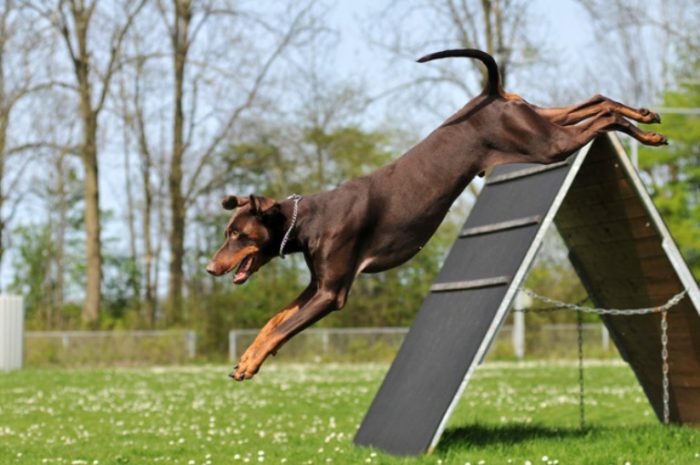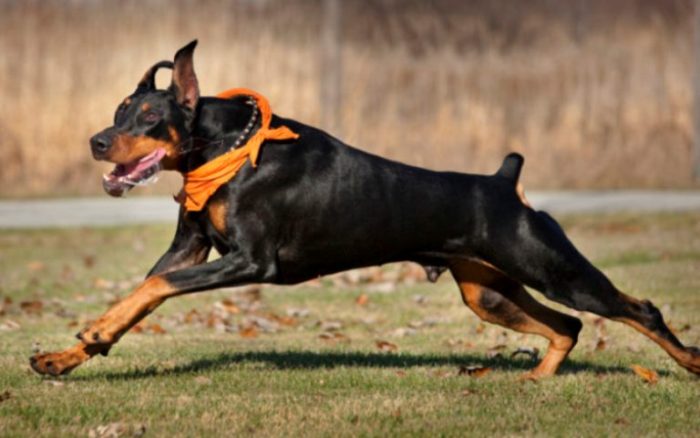Though the Doberman Pinscher breed of canines came into existence towards the end of the 19th century, the pup has gone on to earn a place among the most popular dog breeds in the US. It was first bred in Germany by a German tax collector named Herr Karl Louis Dobermann and gradually spread to other parts of the world. The dog is distinguished by its sleek, elegant, and athletic appearance. The grooming needs of the Doberman Pinscher are minimal, but the question is – does it make a good family dog?
Table of Contents
Origin Of The Doberman Pinscher Dog Breed
Herr Karl Louis Dobermann is a German tax collector who doubles as a nightguard, cop, and dog catcher. His tax collector job meant moving about with large sums of money in dangerous places after dark; this made him feel unsafe. In a quest to safeguard his life and the taxpayers’ money, Louis leveraged his access to the local dog pound and crossed a number of breeds to create what we know today as the Doberman Pinscher dog breed; this happened around the late 19th century.
According to the records, the German wanted to develop a refined but intimidating medium-sized pup. No one is sure of the number of breeds that went into the project but Louis Doberman is believed to have crossed a German Pinscher, Rottweiler, German Shepherd, Great Dane, English Greyhound, shorthaired shepherd, and Manchester Terrier. The end result is the Doberman Pinscher – a brawny, lean dog with a dark coat and brownish markings. Though his initial reason for creating the breed was for it to be used as a guard dog, the pup has since been functioning as a military and police dog, therapy dog, rescue dog, and of course its initial function as a guard dog.
Important Things To Know About the Doberman Pinscher Breed
Health
Though the Dobie is generally a healthy dog with a life span of 10 to 12 years, there are still some health issues associated with the pup. Some of the health challenges that can happen to this breed are:
- Bloat
This is a fatal gastrointestinal problem that can affect a dog at any point in time and it comes with a 50% mortality rate. Dog parents should try to get foreknowledge of the symptoms associated with the condition.
- Hip dysplasia
Perhaps the most common health issue suffered by the Doberman Pinscher dog breed is hip dysplasia – a hereditary condition that prevents the thigh bone from fitting snuggly into the hip bone. This may deteriorate into arthritis with age.
- Progressive Retinal Atrophy (PRA)
The PRA is a condition that entails the gradual deterioration (weakening) of the dog’s retina. The initial symptom is night blindness and with time, the affected pup will also lose sight in the daytime.
- Von Willebrand’s disease
This disease presents an issue with blood clotting; it is a health condition where the blood clotting mechanism is impaired.
- Hypothyroidism
A thyroid gland disorder that can result in epilepsy, obesity, hair loss, dark patches on the skin, lethargy, and many more.
- Wobbler’s Syndrome
This is suspected to be one of the inherited health conditions in the Doberman Pinscher dog breed. When affected, the Dobie suffers from a condition known as spinal cord compression as a result of the instability of the cervical vertebra or malformation of the spinal canal. Extreme symptoms include neck pain and paralysis of the legs.
- Cardiomyopathy
This disease affects the dog’s heart muscles, making them weak and thin. With cardiomyopathy, the heart chambers continue to dilate, resulting in a heart that is abnormally large; heart failure usually follows.
- Albinism
The Dobie suffers from Albinism. The condition is not exclusively associated with white dogs but also exists among pups with pink skin, pink noses, light or blue eyes. Albinism sufferers are highly sensitive to sun rays and susceptible to health conditions like eye problems and cancer.
Other health issues that can be suffered by the Dobie are Color Mutant Alopecia, Narcolepsy, Gastric Dilatation-Volvulus.
Training
The Doberman Pinscher is easy to train, thanks to the pup’s propensity to learn quickly. Besides, the Dobie loves to be busy both mentally and physically, thus, trainers should try and keep lessons fresh, as well as interesting. Though the dog is not overly willful or stubborn (especially with pet parents that provide regular and kind leadership), it does have its own idea about things.
Early socialization (exposure to people, sounds, sight, and experiences) is the key to training the Dobie breed as it helps it develop into a well-behaved pup. A puppy kindergarten is not a bad idea with the dog and you can also take your canine companion to visit the busy parks, stores, and on leisurely strolls just to polish their social skills.
Feeding
A twice-a-day feeding routine of 2.5 to 3.5 cups of high-quality kibble is better than free-feeding (leaving out the food for the dog to eat whenever it gets hungry). The quantity of food needed by dogs depends on variables like activity level, age, size, build, metabolism level. It goes without saying that a couch potato will eat less food than a highly energetic dog.
Grooming
The short coat of the Doberman Pinscher requires minimal grooming. The pup is naturally clean with an insignificant canine odor. Even with the short coat, the dog does shed, thus, brushing should be done weekly; a rubber curry or grooming mitt should suffice for this task. Frequent baths are unnecessary except when your pooch plays in the dirt or rolls in smelly stuff.
Dental hygiene is necessary to prevent periodontal disease. Daily brushing is recommended but two or three times a week can help get rid of tartar build-up and prevent bad breath.
When the dog’s nails start making clicking sounds on the floor, it means that they are overgrown and ready to be trimmed. Employ the services of a groomer or vet if you are not experienced in trimming the nails as bleeding can easily result when you cut close to the blood vessels; this will make your pooch averse to nail trimming.
Bad odor and redness around the ear may be an indication of an infection, thus, a dog’s ears should be subjected to weekly check and this should be done with cotton buds moistened with ear cleaner (PH-balanced). Cleaning is only done for the outer ear and not the ear canal.
Grooming should commence at the puppy stage and the pet parent should try to make the experience a positive one for the pooch with treats, rewards, and praises. Since dogs are rather too touchy about their paws, handling that part of their body should start early enough and must be done frequently as all these lay the foundation for stress-free veterinary examination.
Exercise

The Doberman Pinscher is an extremely active dog and requires vigorous exercise and mental challenge to keep boredom at bay. Any prospective dog parent who wishes to adopt a Dobie must be ready to dedicate quality time to exercise.
Temperament
This athletic and elegant dog breed is intelligent, loyal, alert, and courageous. However, the breed has been stereotyped as highly vicious and aggressive, thus, those who don’t know the dog tend to fear them. But the truth is that a Dobie will never go looking for trouble, they are usually loving, gentle, but very watchful. Though when it perceives danger, especially when it concerns a family member, the Dobie will fearlessly move into defense.
Do They Make Good Family Pets?
Doberman Pinscher is one breed of canines that enjoys family life. The dog loves to be close to loved ones and protects them when the need arises. When you adopt a Dobie, you have an exceptionally loyal and trustworthy canine friend. The dog only takes to aggression with good reason.
Read also: Doberman Puppies; Easy Care And Everything You Need To Know
Other Facts About The Breed
Physical Attributes
Appearance-wise, the dog is sleek, elegant, athletic, and muscular. Other physical attributes of the Dobie include a short red, black, fawn, or brown coat lying very close to the skin. Markings are evident above each eye, throat, muzzle, chest, and limbs. The pup’s head is long and sleek; the males grow up to 26 to 28 inches at shoulder level while the females come shorter at 24 to 26 inches. The weight range for the breed is 60 to 80 pounds with the males slightly heavier. Doberman Pinschers don’t develop rapidly; in fact, the dog retains its puppyish looks until about three to four years.
Are Doberman Pinscher Dog Breeds Good With Children?
Classed as a wonderful family pooch, it goes without saying that Dobie is equally good with children. Especially when the dog has received adequate socialization and training, the Dobie tends to be protective towards kids but in turn, the children must be taught how to be kind and respectful towards dogs; pulling of ear, tail, and taking away the pup’s food should be forbidden. When it comes to interaction with very young children, there must always be supervision.
Can You Rear a Doberman Pinscher In a Multi-pet Home?
A Dobie can cohabit with fellow dogs and other animals in a multi-pet home, especially those that grew up with the dog. However, it perceives dogs outside as a threat and shows aggression towards them
